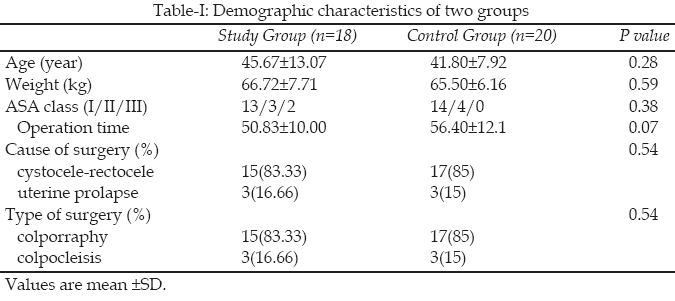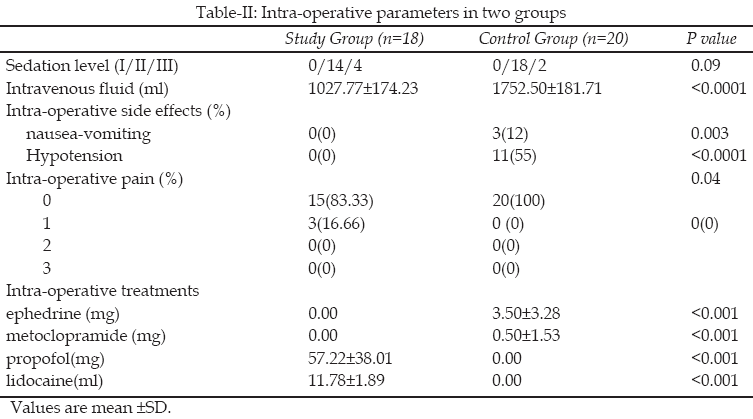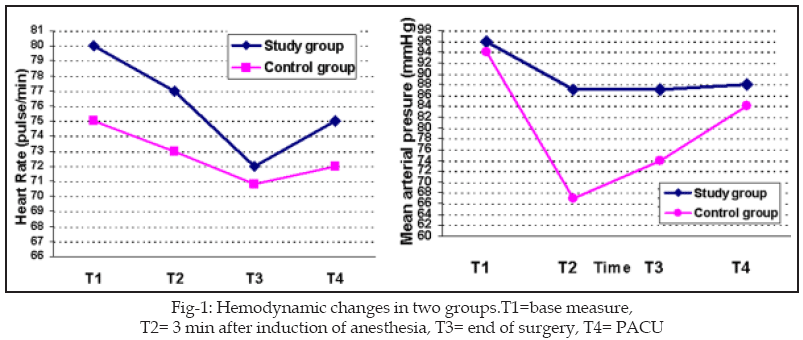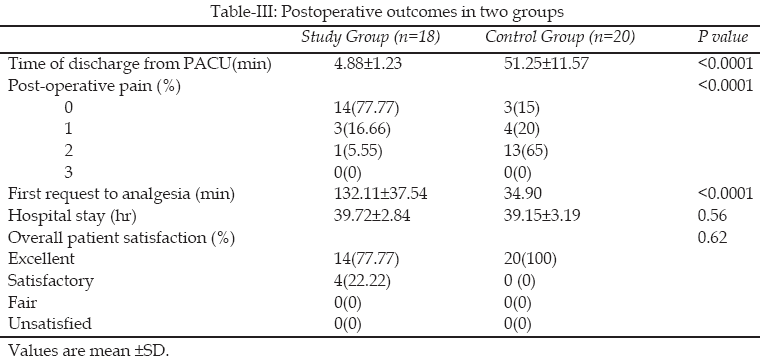|
|
||||
|
Published by : PROFESSIONAL MEDICAL PUBLICATIONS |
||||
|
ISSN 1681-715X |
||||
|
||||
|
- |
||||
|
ORIGINAL ARTICLE |
||||
|
- |
||||
|
Volume 25 |
October - December 2009 (Part-II) |
Number 6 |
||
|
|
||||
|
|
||||
|
|
||||
|
Published by : PROFESSIONAL MEDICAL PUBLICATIONS |
||||
|
ISSN 1681-715X |
||||
|
||||
|
- |
||||
|
ORIGINAL ARTICLE |
||||
|
- |
||||
|
Volume 25 |
October - December 2009 (Part-II) |
Number 6 |
||
|
|
||||
|
|
||||
Comparison of local Anesthesia and Conscious Sedation
with Spinal Anesthesia in Vaginal Reconstructive Surgeries
Atashkhoyi Simin1, Fardiazar Zahra2
ABSTRACT
Objective: There are some studies of feasibility and success of vaginal reconstructive surgeries using local anesthesia. The aim of this study was to compare the combination of local anesthesia and conscious sedation with spinal anesthesia for vaginal repair of advanced vaginal prolapse.
Methodology: Thirty-eight patients with vaginal prolapse as a prospective, randomized and case-controlled clinical trial were operated upon during one year period under local anesthesia with intravenous sedation or spinal anesthesia.
Results: Eighteen women underwent colporraphy, or colpocleisis, using local anesthesia with sedation and 20 patients underwent same procedures using spinal anesthesia. Mean age was 42.18±11.10 years (range 27 to 73). No patient was converted to generated anesthesia. None of patients had intra-operative pain scores >1. Incidence of hypotension (0% v.s 55%; p<0.0001), and blood loss (39.17±13.20 v.s 79.00±18.25 ml; p<0.0001) were lower in the study patients. Duration of anesthesia, time of discharge from post-operative anesthesia care unit (PACU) and the first request to analgesia were significantly different in two groups. Average hospital stay was not different (p=0.56). All 38 patients were very satisfied with their anesthesia experience (p=0.62).
Conclusion: Local anesthesia with sedation can be successfully and safely employed for most vaginal reconstructive surgeries with genital prolapse. This technique is associated with minimal homeostasis and rapid recovery and longer postoperative analgesia.
KEY WORDS:
Vaginal prolapse, Vaginal reconstructive surgeries, Local anesthesia, Intravenous sedation, Spinal anesthesia.Pak J Med Sci October - December 2009 (Part-II) Vol. 25 No. 6 962-967
How to cite this article:
Simin A, Zahra F. Comparison of local Anesthesia and Conscious Sedation with Spinal Anesthesia in Vaginal Reconstructive Surgeries. Pak J Med Sci 2009;25(6):962-967.
1. Atashkhoyi Simin, MD,
Associate Prof of Anesthesiology,
2. Fardiazar Zahra., MD
Associate Prof of Obstetrics & Gynecology,
1-2: Alzahra Hospital,
Tabriz University of Medical Sciences,
Tabriz, Iran.
Correspondence:
Atashkhoyi Simin
E-mail: satashkhoyi@gmail.com
* Received for Publication: November 26, 2008
* Revision Received: September 29, 2009
* Accepted: October 7, 2009
INTRODUCTION
Urogenital prolapse is common in women especially after menopause. Traumatization of the ligamentus and fascia and loss of tone in the muscular compartments of the pelvic floor due to aging, obstetric trauma, and chronic increases in intra-abdominal pressure probable to various forms of prolapse, that are presenting as cystocele, rectocele, or uterovaginal prolapse.
1-3 Due to the frequent coexisting relaxations, the most of vaginal reconstructive surgeries are frequently performed at the same time. Most of these combination surgeries were performed under general (GA) or regional (RA) anesthesia. However, both general and regional anesthesia can cause complications, especially in the elderly and physiologically fragile patients.3-5Local anesthetic infiltration with intravenous conscious sedation is a simple, inexpensive, and safe regimen for pain relief during minimally or more invasive operations. The anesthetic action is rapid, predictable, of short duration and rarely associated with the systemic side effects associated with G.A.Local anesthesia (LA) also is without the effects of sympathetic block associated to spinal anesthesia .
4,5 In addition these procedures are carried out under local anesthesia in the outpatient clinic.6A few studies have been published on vaginal surgery under LA and intra venous (i.v) sedation. Miklos
5 et al performed anterior/posterior colporraphy, and lefort partial colpocleisis under LA in 20 patients with contra indication to GA or RA. In 1996, Ulmmsten6 and coworkers reported an ambulatory surgical procedure under LA for treatment of urinary incontinence in 75 women. Subsequent studies described the technique and outcomes of vaginal repair of concomitant advanced uterine and vaginal prolapse and stress urinary incontinence under intravenous sedation and L.A.7-9 Two studies in 2003 by Axelson10 et al, and Loaurikainen11 et al included women between the ages of 30-85 demonstrating that LA with iv sedation may also be used successfully for vaginal surgery in all ages. Buchsbaum12,13 et al reported the advantages of local anesthesia included minimal interference with homeostasis and rapid recovery with patients often bypassing the recovery unit for vaginal reconstructive surgeries. Two studies showed that tension-free vaginal tape (TVT) using LA is safe, effective and minimally invasive option requiring only a short hospital stay.14,15The aim of this study was to report our experience and quality of analgesia obtained for vaginal repair of pelvic organ prolapse (except vaginal hysterectomy) using local anesthetic infiltration and intravenous conscious sedation compared to spinal anesthesia.
METHODOLOGY
Between April 21, 2007, and April 20 2008, after the Medical Ethics Committee and their written concent, 38 patients, aged 27-73 years, and ASA class I or II, underwent anterior and posterior colporraphy, and colpocleisis using iv sedation with local anesthetic infiltration or spinal anesthesia. All patients complained of severe pelvic pressure and three complained of stress urinary incontinence. All cases underwent preoperative assessment including comprehensive history, general physical examination, and cough stress test. At the time of the preoperative visit, informed surgical consent was obtained and patients were counseled about the options for anesthesia; G.A, RA, and LA with sedation. The advantages of LA are including shorter recovery period, less postoperative nausea and vomiting, no soreness of throat, and less immediate urinary retention on the day of surgery. Patients received prophylactic antibiotics, and sedation (diazepam, 5 mg orally), 30 minutes preoperatively. The patients were then transferred to the operative room and placed in the dorsal-lithotomy position. Intravenous hydration (500-750 ml crystalloid solution) was started, and the vagina and perineum were examined to confirm both the diagnosis and selection of surgical procedure.
Patients were enrolled in two groups randomly by a computer-generated randomization. Of the 38 patients, 18 underwent LA with sedation (study group) and 20 underwent spinal anesthesia (control group). In the study patients sedation was established by the anesthesiologist prior to injection of local anesthetic by surgeon. Sedation was included fentanyl 2ěg/kg and midazolam 0.05mg/kg initially by intravenous bolus. If failed to maintain adequate anesthesia, a continuous intravenous infusion of propofol 2-4 mg/kg/min was initiated. After 5 minutes, local anesthetic infiltration (1.5% lidocaine with 1/200,000 epinephrine) at the vaginal wall defects was performed sub-mucosally.
The amount of sedation required depended on the patient’s weight, desired level of awareness, and duration of surgery. The amount of lidocaine based on the duration of surgery and on the limiting dose for it, which is 3 mg/kg of body weight (maximum dose, 300 mg). Sub-mucosal infiltration was performed using a 22-guage needle. The local anesthetic was injected radically to the lateral extent of the defect. If multiple procedures were performed during one case, each surgical site was injected just prior to incision at that site. In the control group, spinal anesthesia was performed by using of 0.5% bupivacaine 3 ml (15 mg) plus epinephrine 1/200,000 using a 25-guage spinal needle. Anterior and posterior colporraphy and colpocleisis were performed in a conventional manner. The surgeries were performed by four different surgeons. All patients had a spontaneous respiration throughout operation.
Pain scores on a numerical analog scale (NAS; 0=no pain, 3=worst pain imaginable) were assessed during operation. When the patient had a NAS >2, LA was converted to G.A.
Monitoring during anesthesia consisted of continuous heart rate (HR) and o2 saturation (spo2), non-invasive blood pressure (NIBP), and electrocardiography (ECG). Hemodynamic parameters changes from >30% of base value was treated by atropine 0.5 mg to maximum dose 2 mg and ephedrine 5 mg to maximum dose 50 mg for treatment decreases HR and BP respectively. Sedation level was evaluated by Ramsay
4 et al scoring. "Operation time" is defined as when the surgeon initiated the operation and ended with the last suture placement. "Anesthesia time" is defined as when the anesthesiologist initiated the sedation (in the study patients), or spinal anesthesia (in the control patients) and ended with the patient discharge from post-anesthesia care unit (PACU). Other information consisted of estimated blood loss, intensity of pain immediately postoperative, time of discharge from PACU, length of hospital stay, and overall satisfaction with anesthesia.The SPSS 14.0 program (SPSS Inc., Chicago, IL) was used to analyze the statistical data. Data were compared using student t test and chi-square test. p <0.05 was considered statistically significant.
RESULTS
A total of 38 patients underwent vaginal reconstructive surgeries in a year. Eighteen patients underwent surgery using local anesthesia and conscious sedation, and in the 20 other patients were operated under spinal anesthesia. There were 35 anterior and posterior colporraphy and three colpocleisis. Any of patients did not need to general anesthesia.
The mean age of patients was 42.18±11.10 years, with range 27 to 73 years. There was no statistical difference between two groups as regards age, weight, ASA class, type and duration of surgery (Table-I).

Intra-operative findings are listed in Table-II. None of the patients had intra-operative pain score > 1, so local anesthesia or spinal anesthesia was not converted to general anesthesia. Propofol with a mean dose of 57.22±38.01 mg was used as supplement to sedation in the study group and an average of local anesthesia was 11.87±1.89 ml in these patients.

All patients in two groups were in the sedation level of II-III throughout procedure. None of study group experienced intra-operative nausea, but 3 (12%) patients of control group had nausea intra-operatively (p=0.003). Mean estimated blood loss was lower in the study group (39.17±13.20 ml vs 79.00±18.25ml; p<0.0001). Average intravenous fluid, ephedrine, and metoclopromide consumption was lower in study patients (p<0.0001 for each parameters).
Mean of heart rate (HR) changes were not significantly different between two groups throughout anesthesia, but hypotension was higher in control group (p<0.0001; Fig-1).

Postoperative outcomes are listed in Table-3. Most of study patients were admitted directly to the floor bypassing the PACU (mean length 4.88±1.23 min) but mean length of stay at PACU in the control group was 51.25±11.57 min (p<0.0001). Therefore, duration of anesthesia in the control group statistically was longer than the study patients (p<0.0001). Postoperative pain score was lower in study patients (p<0.0001) and the first request to analgesia was longer in the study group (132.11±37.54 v.s 34.90±5.54; p<0.0001). All patients in the two groups were discharged within 42 hours of surgery (p=0.56).

All the patients of two groups were very satisfied with the method of anesthesia during their operation, and there was no significant differences between two groups (p=0.62). Only 3(16.66%) patients of study group reported to experience mild pain during the posterior colporraphy (p=0.04).
DISCUSSION
All anesthesia methods have the potential for risks and complications. General anesthesia is known to have potentially detrimental effects on the cardiovascular, respiratory, gastrointestinal and the central nervous systems, where it has been found to cause postoperative transient confusional status in more than half of all elderly patients
3-5. Regional anesthesia is associated with physiologic effects and side effect perioperatively. In addition, it is contraindicated in the coagulopathies.3,4A few studies have been published on vaginal surgery under local anesthesia with intravenous sedation. Most of these studies were retrospective, and they have been reported in the elderly patients undergoing anterior and posterior colporraphy and lefort type colpocleisis.
5-13This randomized and case-controlled clinical trial was performed by local anesthesia with sedation in the vaginal reconstructive surgeries compared to spinal anesthesia. The patients had a range age of 27-73 years. This shows, local anesthesia with sedation may be considered an alternative to GA or RA for vaginal reconstructive surgeries in women of all ages. Buchsbaurn
12 et al were revealed this method of anesthesia can be successfully employed for younger women.The study patients had a pain score 0-1 during procedure, that shows the sedation with LA safely and successfully can use for vaginal reconstructive surgeries.
5-15Incidence of hypotension was lower in the study patients, because LA is not associated with hemodynamic disturbance.
3-5 Therefore; the need to ephedrine for treatment of hypotension was lower in these patients. Blood lose was less in the study patients, that is may be due to using epinephrine with lidocaine. Jomaa8 et al showed that intra-operative bleeding was low in patients when their operation was performed under local anesthesia.The patients of the study group bypassed the PACU and admitted directly to the floor. LA can reduce anesthesia side effects and eliminates the need for PACU time required for patients to emerge from GA or regress motor block with R.A. Thus allowing for more efficient operating room turnover, and costs are saved when patients bypass the PACU
12.The patients of the study group did not have postoperative pain immediately after surgery. Duration of lidocaine for the nerve blocks is longer than spinal anesthesia.
4 Duration of analgesia is prolonged significantly when epinephrine is added to the lidocaine.4,5The patients can be discharged earlier within 24 hours of surgery. The majority of our patients of two groups had bladder catheter, so the patients were discharged home withen 24-45 hours of surgery.
All the patients were satisfied with their anesthesia experience. This type of anesthesia regarded to effectiveness of analgesia during procedure. Early ambulation, earlier home discharge, and high level of satisfaction were reported by patients.
5-15In conclusion, the results of this study demonstrate the vaginal reconstructive surgeries can be performed safely and successfully with local anesthesia and sedation for all patients in all ages. This study illustrates this technique is associated with limiting the potential risks of RA and a need of short time postoperative observations, low postoperative complication rate, and high level of satisfaction reported by the patients.
REFERENCES
1. Bereck JS. Novak s’ Gynecology.13th ed, Lippincott Williams & Willkins, Philadelphia Baltimor, New York. 2002;685-93.
2. Barash PG, Cullen BF, Stoelting PK. Anesthesia for the geriatric patient. In Handbook of clinical Anesthesia. 4th ed. Lippincott Williams & Willins, Philadelphia. 2001;648-61.
3. Jaffe RA, Sumuels SI. Anesthesiologists’ manual of surgical procedures.2nd ed. Lippincott Williams & Willins, Philadelphia 1999;592-8.
4. Miller RD. Miller’s Anesthesia. 6th ed. Elsevier Churchill Livingstone, Philadelphia Pennsylvania. 2005;2609-11:2798-9.
5. Miklos JR, SZE EHM, Karram MM. Vaginal correction of pelvic organ relaxation using local anesthesia. Obestet Gynecol 1995;86(6):922-4.
6. Ulmsten U, Henriksson L, Johnson P, Varhos G. An ambulatory surgical procedure under local anesthesia for treatment of female urinary incontinence. Int Urogynecol J Pelvic Floor Dysfunct 1996;7(20):81-5.
7. Norris A, Scrri A, Powell M. Quality of anesthesia for insertion of tention-free vaginal tape using local analgesia and sedation. Eur J Anesthesiol 2001;8(11):755-8.
8. Jomaa M. Combined tension-free vaginal tape and prolapse repair under local anesthesia in patients with symptoms of both urinary incontinence and prolapse. Gynecol Obstet Invest 2001;51(3):184-6.
9. Moore RD, Miklos JR. Colpocleisis and tension-free vaginal tape sling for severe uterine and vaginal prolapse and stress urinary incontinence under local anesthesia. J Am Assoc Gynecol laparosc 2003;10(2):176-80.
10. Axelsen SM, Bek KM. Anterior vaginal wall repair using local anesthesia. Euro J Obstet Gynecol Reprod Bio 2004;112(2):214-6.
11. Laurikainen E, Kiilbolma P. The tention –free vaginal tape procedure for female urinary incontinence without preoperative urodynamic evaluation. J Am Coll Surg 2003;196(4):579-83.
12. Buchsbaum GM, Albushies DT, Schoencker E, Duecy EE, Glant JC. Local anesthesia with sedation for vaginal reconstructive surgery. Inter Urogynecol J Induced Pelvic Floor Dysfunct 2006;17(3):211-4.
13. Buchsbaum GM, Duecy EE. Local anesthesia with sedation for trans-vaginal correction of advanced genital prolapsed. Am J Obstet Gynecol 2005;193(6):2173-6.
14. Atherton MJ, Stanton SL. The tention-free vaginal tape reviewed; an evidence-based review from inception to current status. Int J Obstet Gynecol 2005;112(5):534-46.
15. Lo TS, Wang AC, Liang CC, Long CY, Lee SJ. Treatment for unsuccessful tention-free vaginal tape operation by shortening pre-implanted tape. J Urolog 2006;175(6):2196-200.